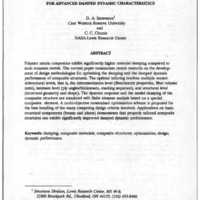-
Title
-
Integrated Optimization Of Composite Structures For Advanced Damped Dynamic Characteristics
-
Report Number
-
WL-TR-91-3078 Volume I, p. DCA-1 thru DCA-15
-
Creator
-
Saravanos, D. A.
-
Chamis, C. C.
-
Corporate Author
-
Case Western Reserve University
-
NASA-Lewis Research Center
-
Laboratory
-
Wright Laboratory
-
Date
-
1991
-
Date Issued
-
1991-08
-
Extent
-
15
-
Contract
-
Laboratory Research - No Contract
-
DoD Project
-
2401
-
DoD Task
-
240104
-
Identifier
-
ADA241311
-
Format
-
1 online resource
-
Abstract
-
Polymer matrix composites exhibit significantly higher material damping compared to most common metals. The current paper summarizes recent research on the development of design methodologies for optimizing the damping and the damped dynamic performance of composite structures. The optimal tailoring involves multiple material/structural levels, that is, the micromechanics level (fiber/matrix properties, fiber volume ratio), laminate level (ply angles/thicknesses, stacking sequence), and structural level (structural geometry and shape). The dynamic response and the modal damping of the composite structure are simulated with finite element analysis based on a special composite element. A multi-objective constrained optimization scheme is proposed for the best handling of the many competing design criteria involved. Applications on basic structural components (beams and plates) demonstrate that properly tailored composite structures can exhibit significantly improved damped dynamic performance.
-
Description
-
Polymer matrix composites exhibit significantly higher material damping compared to most common metals. The current paper summarizes recent research on the development of design methodologies for optimizing the damping and the damped dynamic performance of composite structures. The optimal tailoring involves multiple material/structural levels, that is, the micromechanics level (fiber/matrix properties, fiber volume ratio), laminate level (ply angles/thicknesses, stacking sequence), and structural level (structural geometry and shape). The dynamic response and the modal damping of the composite structure are simulated with finite element analysis based on a special composite element. A multi-objective constrained optimization scheme is proposed for the best handling of the many competing design criteria involved. Applications on basic structural components (beams and plates) demonstrate that properly tailored composite structures can exhibit significantly improved damped dynamic performance.
-
Distribution Classification
-
1
-
Distribution Conflict
-
No
-
DTIC Record Exists
-
No
-
Illinois Tech Related
-
No
-
Photo Quality
-
Not Needed
-
Report Availability
-
Full text available
-
Type
-
article
 article27
article27